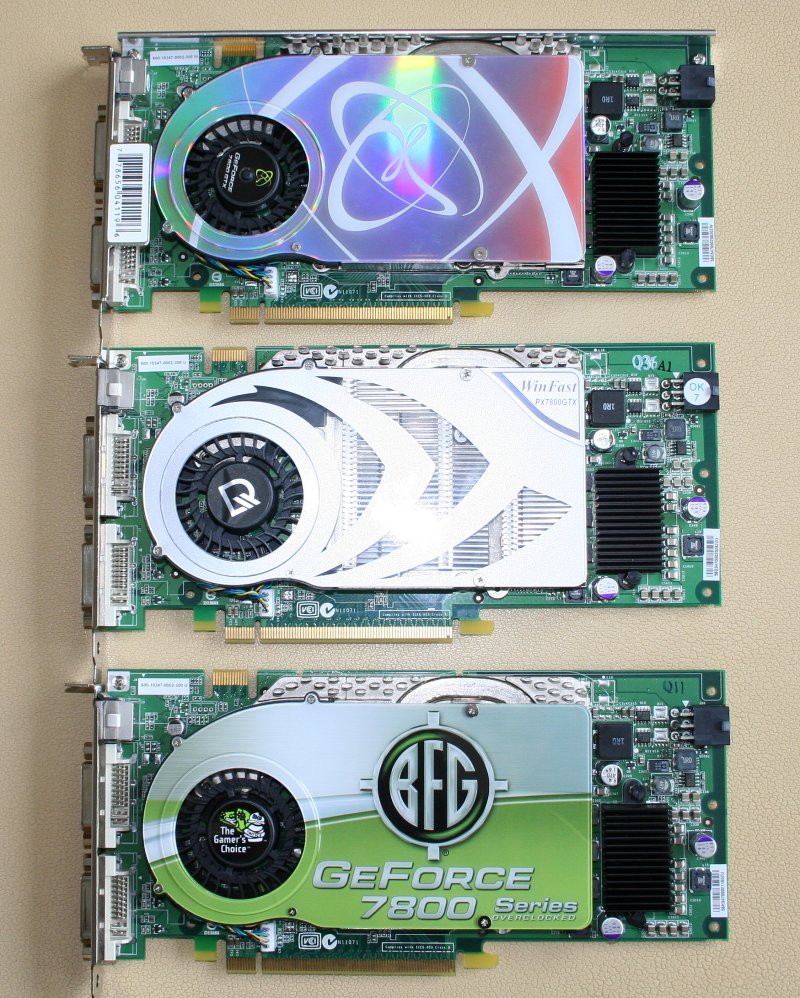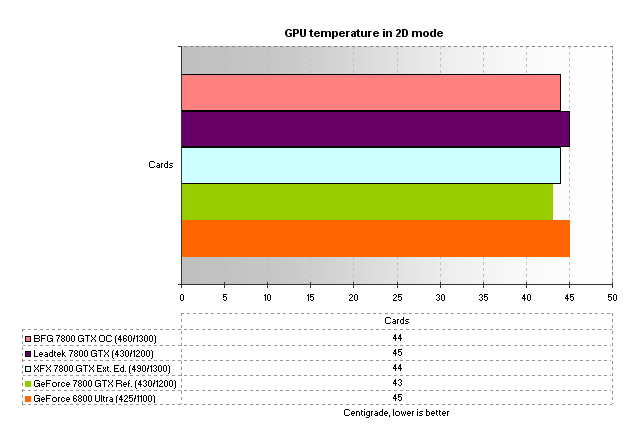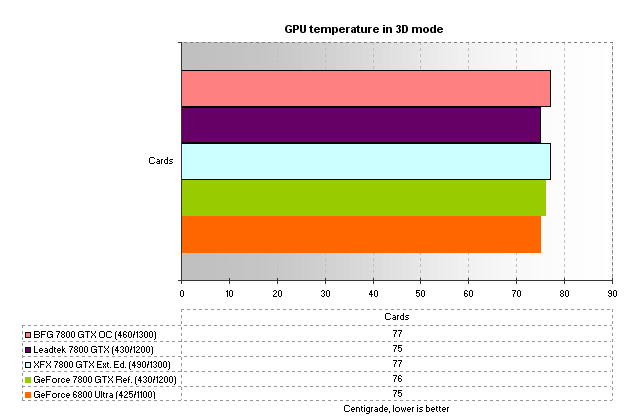General observations
General observationsSize
We've seen each card in isolation and determined that, apart from core and memory speed, all cards are very, very similar in design.

Here's all three protagonists together. If we were to swap over the cooler covers and badges on the fan, we reckon it would be an impossible task to tell which is which. No marks here for company-specific design or cooling. We guess that the firms go by the maxim of 'if it's not broke, why fix it?'

Here's the BFG GeForce 7800 GTX OC sitting above a regular GeForce 6800 Ultra and ATI RADEON X850 XT PE. GeForce 7800 GTXs are significantly wider than ATI's current flagship card and around an inch wider than the already-wide GeForce 6800 Ultra. A typical 7800 GTX PCB, excluding the DVI ports and any space required for the 6-pin power connector, measures in at around 233mm width, so make sure your chassis can accommodate it. Running the test cars in a Cooler Master WaveMaster case resulted in a snug fit between the card and a hard drive mounted at the same height. What the 7800 GTX has over the two lower cards is bags more performance once I.Q. is increased, and a single-slot design.
Noise
All three retail GeForce 7800 GTX cards used identical fans supplied by Delta Electronics. The fans are quiet enough when running at full-blown 3D mode to be masked by other noise-making components in a regular, top-end system. All three cards were comfortably quieter than a GeForce 6800 Ultra and ATI RADEON X850 XT PE. GeForce 7800 GTX manages to successfully marry performance to relative quietness.
Heat considerations
The quartet of GeForce 7800 GTX cards and the single GeForce 6800 Ultra all have in-built temperature sensors whose reporting can be accessed through the driver's control panel. Ambient temperature was 20c and each card was left idling in Windows, without a screensaver, for 10 minutes. Note that GeForce 7800 GTX GPUs run at 275MHz core when in 2D mode. No extra cooling was directed at the cards.

All much of a muchness. Idling isn't going to test the GPU's ability but it's nice to know that the cards are running at no more than 25c above ambient temperatures.

RTHDRIBL, the fancy-looking benchmark with plenty of eye candy, was run in a 640x480 window for 15 minutes to gauge card load temperatures. All cards were run at their respective 3D frequencies, with XFX's Extreme Edition the fastest at 490MHz core and 1300MHz RAM.
Again, very little in it, with all 7800 GTX cards comfortably under the GPU threshold of 115c.
What the above graph doesn't highlight is just how warm other parts of the cards get when run under sustained 3D load. Take XFX's as an example. The holding bar becomes so hot that it is nearly impossible to touch. BFG's power-delivery heatsink, in common with others, is so hot that, after being immediately switched off, the card cannot be removed safely without waiting a few minutes for the heatsink to cool down; it's positively burning. The same is true of the RAM heatsink on the rear of all GeForce 7800 GTX cards. Handle with care seems apt.
2D quality
When run via DVI and connected to a Dell 2001FP 20-inch TFT, each card produced a crisp, detailed image that's beyond reproach. There really isn't a quality distinction between ATI and NVIDIA's 2D quality now.
Power considerations
A decent-quality 400W PSU is recommended as a minimum for running a single GeForce 7800 GTX card. Add another 100W if you plan to add a second in for some SLI lovin'. Our test system was powered by an OCZ PowerStream 520W PSU, and we had no stability problems during a week of testing.
Warranty and support
The quality of a given company is can be best judged by its returns procedure. Responsible firms allocate a reasonable percentage of product sales to top-class after-sales support.
BFG
BFG's warranty is comprehensive enough, offering the original purchaser a limited lifetime warranty on its card. Further, it provides 'free' 24/7 technical support via freephone in the U.S. and via email for the rest of the world. From what we can gather, BFG's RMA procedure and general after-sales support is above average for the industry.
Leadtek
Leadtek's PX7800 GTX TDH carries a 12-month warranty which remains valid if the end-user flashes the card with a Leadtek-approved BIOS, one that overclocks the core and RAM to 450MHz/1250MHz. We'd like to have at least a 3-year warranty on a premier card such as the PX7800 TDH MyVIVO.
XFX
XFX's European support is handled by Propellerhead. What's not pleasing is that calls to Propellerhead are charged at 60p/m. Email support is free, though. XFX's GeForce 7800 GTX Extreme Edition carries a limited (aren't they all?) 2-year warranty.
BFG wins on the warranty front.









